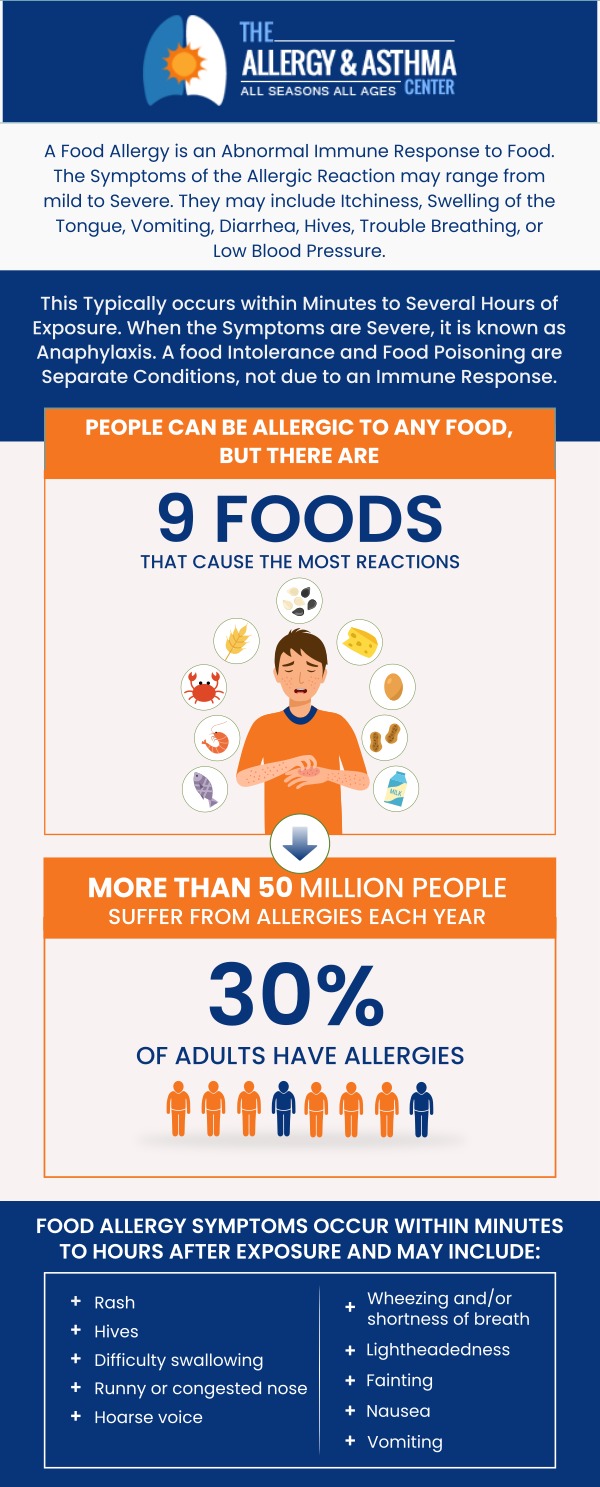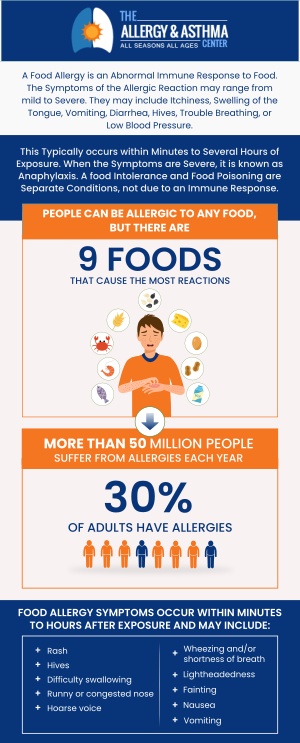Food Allergy Testing & Treatment Clinic Questions and Answers
To assess whether you have a food allergy, an allergist may offer allergy testing such as a skin test or blood test that helps to evaluate if your body has an allergic response to a specific food. Dr. Jon E. Stahlman, MD specializes in the diagnoses and treatment of adult and pediatric food allergies. Visit The Allergy & Asthma Center today! We are ready to serve you. For more information, please contact us or book an appointment online. We serve patients from Lawrenceville GA, Atlanta GA, Conyers GA, Suwanee GA, Duluth GA, Grayson GA, Decatur GA, Brookhaven GA, Lithonia GA, and Covington GA.




Table of Contents:
How prevalent are food allergies?
Are there different types of food allergies?
Immediate hypersensitivity food reactions
Delayed hypersensitivity food reactions
Can babies and infants be allergic to foods?
Can one be allergic to more than one food in a food family?
What is the best treatment for food allergies?
Food allergies can be one of the most frustrating and complex allergy issues facing physicians, patients, and families. Considering the unlimited number of foods (and food additives) that are consumed; the variable time between ingestion and the allergic reaction; and the varied and often subtle symptoms which result; it seems miraculous when the food that is causing the symptoms is actually identified.
Although an individual may be allergic to any food, there are eight foods that account for 90% of all food allergic reactions. These are: milk, eggs, peanut, tree nuts, fish, shellfish, soy, and wheat.
Approximately 4% of Americans are estimated to have food allergies. The prevalence of food allergies is highest (6-8%) in infants and young children under three years old. Fortunately, the incidence of documented food allergies decreases with age, probably due to the development of tolerance in children allergic to milk, wheat, soy, and eggs. Of the 2.5% of children allergic to milk, approximately 80% will “outgrow” their allergy by five years of age. Of all of the foods, peanuts are least likely to be outgrown. Recent studies have shown that only about 20% of children will lose their hypersensitivity to peanuts.
For purposes of simplicity, food allergies can be divided into two types: the immediate hypersensitivity reaction and the delayed hypersensitivity reaction.
The immediate allergic reaction is the best understood, most easily diagnosed, but the most serious of all allergic reactions. This reaction represents the “classic” allergic reaction. At the cellular level, an allergen (the food protein) comes in contact with an IgE antibody specific to that food, resulting in the release of histamine and a multitude of other chemical mediators. Once released into the tissues and circulation, these mediators cause an immediate allergic reaction.
This reaction, which generally occurs within minutes after ingestion of the allergenic food, can be relatively mild or severe. Symptoms of a relatively mild to moderate reaction might include a rash (urticaria, commonly referred to as hives), itching, generalized redness of the skin, heat, facial or eyelid swelling, nausea, abdominal cramping, vomiting and/or diarrhea. Such reactions are generally treated with a quick acting antihistamine and generally run their course over a few minutes to hours.
The most severe allergic reactions, or anaphylaxis, generally have a rather quick onset after the food is eaten. Symptoms might include those mentioned above, but, can rapidly progress to difficulty breathing (chest tightness due to bronchial constriction and swelling of the airways), a drop in blood pressure leading to shock, and even death. Anaphylaxis, or impending anaphylaxis, must be treated immediately. Epinephrine (adrenaline), which is available for self administration, must be given immediately, and repeated, if necessary. This represents a true medical emergency and should never be taken lightly.
Any person who has possibly experienced an immediate allergic reaction to a food should consult a board certified allergist. The allergist will likely test the patient, either through the skin or blood, in order to identify or confirm the allergenic food. Once it has been determined which food(s) caused the immediate allergic reaction, the allergist will consult with the patient and family about the elimination of the food(s) from the diet and the management of any further reactions.
A delayed food allergy reaction, while less dangerous in terms of one’s immediate health, can be much more difficult to diagnose and treat. As the name implies, there is often a delay of usually hours to days between the time of ingestion and the onset of symptoms, making the history less valuable in establishing a cause and effect relationship.
Part of the difficulty in diagnosing these reactions is that there is not yet available a reliable allergy test which can accurately diagnose or predict a delayed reaction. Allergy skin testing and RAST or ImmunoCap blood tests are not helpful, as they measure only the IgE antibody, the antibody responsible for immediate reactions. Research has not yet identified the antibody or antibodies responsible for delayed reactions, although there has been considerable interest and research in the possible role of the IgG antibody in the delayed allergic reaction. There is now a blood test available to measure this antibody, but its reliability as a predictor of delayed allergy has not yet been established.
The optimal method of determining whether one is suffering from a delayed hypersensitivity reaction, and to which food(s), is the elimination diet. Elimination or reduction of symptoms after the avoidance of the offending food(s) from the diet may take weeks to see, therefore, one must be very patient. The most common foods likely to cause delayed reactions are milk and dairy products, and wheat and other grains.
The symptoms resulting from a delayed reaction can involve several organ systems and may be quite subtle in their presentation. In addition to more classic allergy symptoms such as nasal congestion, runny nose, rash (eczema or hives), etc, delayed reactions may present with symptoms such as frequent headaches, recurrent or chronic abdominal pain, lethargy, irritability, dark circles under the eyes, limb pain, and recurrent ear or sinus infections, to name a few.
Food allergies in babies and infants can be especially challenging. Symptoms of a food allergy may include colic (irritability), excessive spitting (even projectile vomiting), rashes including eczema or hives, nasal symptoms including congestion and/or runny nose, coughing or wheezing, diarrhea (sometimes bloody), constipation, and even poor weight gain.
If a baby under a year of age is truly allergic, it is almost always caused by a food. And, the food most likely to be responsible is cow’s milk. It is important to know that 20-30% of milk allergic babies are also allergic to soy.
It is also possible for babies who are exclusively breast fed to be allergic to a food protein being passed through the nursing mother’s milk. In such a case, it is likely that the baby is reacting to a food eaten by the nursing mother, such as milk and/or dairy products.
It is also important to be aware that many foods can cross react with other foods within the same food group or family. Familiarity of food groups is a must for the food allergic individual.
The treatment advocated by allergy specialists for food allergies for many years has been avoidance. Avoidance works well for most food allergies but does present challenges for patients and their families. Recent research has suggested that there may be other forms of therapy depending on the age of the individual. Studies have shown the prevention of certain food allergies is now possible with early introduction of that food. Currently the American Academy of Pediatrics recommends introducing peanut protein (in an infant safe form) starting at age 6 months if possible for most children (and as early as 4 months for high risk children with eczema or an egg allergy).
New therapies to protect patients who have been diagnosed with a food allergy are also nearing everyday use including forms of oral immunotherapy and possibly patches that can be worn to prevent allergic reactions. Your board certified allergist is the best resource for helping decide if any of these therapies are best for you or your child.

Additional Allergy & Asthma Services
▸ Allergy Shots
▸ Allergy Testing
▸ Asthma
▸ Bronchodilators
▸ Drug Allergy
▸ Food Allergy
▸ Insect Allergy
▸ Nasal/Sinus Allergies
▸ Pediatric Allergy
▸ Pediatric Asthma
▸ Skin Allergy
▸ Spring Allergies




